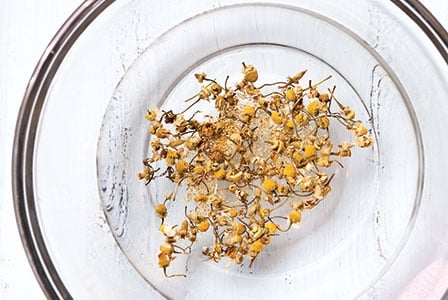
DIY steam treatments can help keep skin clear and healthy. Try a herbal steam infusion by adding dried herbs to your steam bath to soothe and clarify skin.
Steam has long been used as a therapeutic treatment. Eastern medicine has used steaming for centuries, such as in Ayurveda’s swedana therapy, and other cultures have created spaces devoted to steaming in hamams (Turkish baths) and sweat lodges for relaxation and detoxification.
Full steam ahead
Not only is steaming used for health purposes, but it is also an excellent beauty treatment. Steam helps to balance complexions, clear away clogged pores, and lubricate skin tissue, helping to treat acne, dehydration, and comedones (blackheads and whiteheads).
Estheticians often use the power of steam during facial services to soften the skin’s surface and prepare it for pore extracting. However, steaming does not need to be performed by a professional; it can be done as a quick and simple treatment within the comfort of your home. Weekly steaming can be incorporated easily into your regular beauty routine to clarify the skin and promote a balanced complexion.
Steam beauty benefits
Pore decongestion
Steaming helps us to sweat out skin impurities and toxins. It draws out pore buildup from the deeper layers of our skin, purging congestion without being invasive. Comedones are often a result of dried out facial sebum (oil) that has become hard from dehydration. Facial steaming helps lubricate the skin, allowing comedones to move their way out of the skin.
Breakout prevention
While facial steaming can help to dislodge pore congestion, it is just as effective at preventing comedones to begin with. Regular steam treats dehydration—a factor in pore buildup—and increases circulation in the skin. The blood system feeds and oxygenates the skin and transports waste away from its cells, making good circulation key in maintaining a healthy, clear complexion.
Easy pore extraction
Steaming is an important preparation step for extracting pore buildup. It softens the skin’s surface and opens up pores, allowing extractions to come out more easily and thereby preventing facial bruising and scarring.
Skin hydration
Research has found that warm steam is hydrating for the skin and also increases its permeability. Therefore, skin tissue more easily absorbs moisture from skin care products and the external environment after steaming. This, along with the enhanced absorption that clean pores provide, increases the skin’s suppleness.
Herbal steam infusions
While there are many benefits to just steaming with plain H2O, the addition of dried herbs to your steam bath makes it even more therapeutic. Research has shown that steam increases the skin’s permeability, so these herbal additions enable your skin to absorb their healing properties more deeply. The following common kitchen herbs have extraordinary beautifying powers.
Camomile
Camomile has calming effects on our skin and has been found to be antiallergic, making it great for soothing sensitive and reactive complexions. It also treats acne, as camomile is an antimicrobial and antioxidant and may have anti-inflammatory effects on red and inflamed pustules. Adding two bags of camomile tea to your steam bath helps tailor your treatment to hypersensitive and broken-out skin types.
Sage
Sage is a strong antibacterial ingredient that purifies the skin. It is astringent and clarifying, making it good for oily complexions with open pustules and cystic acne. Add half a handful of loose dried sage leaves to your steam water to infuse it with these detoxifying properties.
Green tea
Green tea (from the Camellia sinensis plant) has been found to help prevent UV damage when applied topically. It also increases the immune function of the skin, helping to increase its overall health. Adding green tea bags to your steam treatment will allow its active ingredients to permeate the deeper layers of the skin, offering protection against the elements.
DIY steaming
What you need:
1 kettle
1 large glass bowl
Purified water
Herbs or tea, if desired
1 large towel
1 face cloth
Fill kettle with water and bring to boil. Pour water into a large glass bowl, and add loose herbs, tea, or essential oils. Then, hover your face approximately 6 in (15 cm) above the bowl and place the large towel over your head like a tent, entrapping the steam. Relax in this position for 5 to 10 minutes. Those with sensitive skin should not steam for more than 5 minutes, and should hover 8 in (20 cm) away from the bowl.
After steaming, blot your skin gently with face cloth and apply a high quality, natural moisturizer. It is important to do this post-steam to restore any moisture that has been perspired away. For a full evening of skin pampering, exfoliate before steaming, and apply a treatment mask afterward, creating a mini-facial experience. This will leave your skin feeling refreshed, clean, and detoxified.
More natural beauty tips for clarifying the skin
Avoid drying agents
It may seem counterproductive, but keeping the skin hydrated is critical to a clear complexion. Avoid drying chemical agents and detergents such as sodium lauryl sulphate in your skin care routine; these ingredients strip the skin’s protective barrier, leaving it vulnerable to infection.
Manage inflammation
Acne is not only caused by infection, but also a result of inflammation—this is why blemishes can appear hot, swollen, and red. Keeping the skin calm and cool is important. Using purifying yet soothing ingredients such as neem, camomile, and aloe vera can help do this.
Keep up bowel care
Paying attention to regular elimination and healthy intestinal flora is important for glowing, blemish-free skin. Researchers have found a correlation between bowel dysfunction and acne.
Exfoliate
Like steaming, exfoliation removes cellular buildup and debris from our skin. Manual scrubs slough away dead cells and help alleviate pore congestion. Look for natural ingredients such as jojoba beads and chickpea flour to clarify the skin without causing irritation. Those with ultrasensitive skin may want to opt for a natural peel instead to avoid abrasion. Look for one containing fruit acids or sugar cane.







